Zephyr
Hazard to Others
  
Posts: 341
Registered: 30-8-2013
Location: Seattle, WA
Member Is Offline
|
|
Cadmium Sulfide Preparation
This post will summarize my recent synthesis of cadmium sulfide.
Warning: This procedure involves the evolution of hydrogen sulfide gas which is very poisonous.
The Procedure:
0.97 grams of cadmium metal are added to 40ml of hot 30% hydrochloric acid.
The acid is kept at 90oC and additional hydrochloric acid is added periodically to maintain 40ml of liquid.
These conditions are maintained until all of the cadmium metal has reacted to form cadmium chloride which has dissolved in the solution.

The solution is added to a 125ml Erlenmeyer flask and diluted with 30ml of cold water and set aside to cool.
5.39 grams of 5µm aluminum powder are mixed with 9.61 grams of sulfur in a steel crucible.
The mixture is moved outside and ignited.

The reaction is very exothermic and reaches thempatures of over 1100oC, similar to a thermite.
This reactionis 2 Al + 3 S → Al2S3

Once the reaction was complete I was left with a pool of liquid aluminum sulfide (Al2S3).

The crucible was left to cool for several minutes and then the rigid aluminum sulfide was broken into small pieces with a chisel. This must be
done in a well ventilated area as aluminum sulfide reacts with moisture in the air to form the poisonous gas hydrogen sulfide.

The chunks of aluminum sulfide are dumped into the dilute cadmium chloride solution.
The aluminum sulfide Al2S3 reacts with water to form aluminum hydroxide [Al(OH)3] and evolves hydrogen sulfide
gas (H2S) which reacts with the cadmium chloride (CdCl2) to form the bright yellow cadmium sulfide (CdS) and hydrochloric acid
(HCl). This must be done in a fume hood because of the large amounts of excess hydrogen sulfide gas which escape the reaction.
The first step of the reaction is: Al2S3+6H2O ---> 3H2S+2Al(OH)3
The second step of the reaction is: H2S+CdCl2 ---> CdS+2HCl

The solution is left to react for several hours, still in the fume hood, and them decanted into a vacuum filter.
The left over residue:

The filtering of the cadmium sulfide:

The filtrate is dried and weighed.

My yield was 0.82 grams. That is a 65.77% yield based on cadmium.
|
|
|
Bezaleel
Hazard to Others
  
Posts: 444
Registered: 28-2-2009
Member Is Offline
Mood: transitional
|
|
Sorry that I missed it, but how did you effect the separation of you aluminium hydroxide and sulphide leftovers from your cadmium sulphide? I guess
that both of them are insoluble. Did CdS remain in suspension, and the aluminium compounds not?
|
|
|
blogfast25
International Hazard
    
Posts: 10562
Registered: 3-2-2008
Location: Neverland
Member Is Offline
Mood: No Mood
|
|
Bezaleel:
Where he writes:
"The first step of the reaction is: Al2S3+6H2O ---> 3H2S+2Al(OH)3"
... that's not really correct: the procedure is carried out with excess HCl present, so AlCl3 forms. CdS is so insoluble (small Ksp) that it
precipitates even in those acid conditions. With Ni or Zn this procedure would not work, because their resp. Ksp values for the sulphides aren't small
enough.
Also, it isn't really 'the first step of the reaction': two reactions take place here. 'The first step of the procedure' would be a mildly better way
of putting it.
A nice experiment and good write up but personally I'd be more interested in converting CdS to Cd!
[Edited on 8-4-2014 by blogfast25]
|
|
|
MrHomeScientist
International Hazard
    
Posts: 1806
Registered: 24-10-2010
Location: Flerovium
Member Is Offline
Mood: No Mood
|
|
I really like this method. Nice writeup! I've been wanting to make CdS for a while now, simply because it's the classic "school bus yellow!" (Plus I
really have nothing to do with my excess cadmium metal.) I want to use this procedure for a video on my channel, and if I do I'll credit this thread
for the idea.
|
|
|
sasan
Hazard to Self
 
Posts: 92
Registered: 22-2-2014
Location: TEHRAN / IRAN
Member Is Offline
Mood: Radiative
|
|
I make this sulfide recently by treating the solutions of sodium sulfide and cadmium chloride
It has different colors depends on the production method,temprature
I saw somewhere if you boil the suspension of cadmium sulfide immediately after its creation is the solution,you would get more reddish cadmium
sulfide,mine is dark orange yellow not school bus yellow,and I think school bus yellow is lead yellow(lead chromate)not cadmium sulfide
|
|
|
blogfast25
International Hazard
    
Posts: 10562
Registered: 3-2-2008
Location: Neverland
Member Is Offline
Mood: No Mood
|
|
If you mean real paint for school buses, that probably contains neither lead, nor Cr(VI), nor cadmium by now... 
|
|
|
Zephyr
Hazard to Others
  
Posts: 341
Registered: 30-8-2013
Location: Seattle, WA
Member Is Offline
|
|
Thank you for all of the positive feed back!
Quote: Originally posted by MrHomeScientist  | | I really like this method. Nice writeup! I've been wanting to make CdS for a while now, simply because it's the classic "school bus yellow!" (Plus I
really have nothing to do with my excess cadmium metal.) I want to use this procedure for a video on my channel, and if I do I'll credit this thread
for the idea. |
I have really enjoyed your other videos, and would be happy to see a video of this synthesis.
|
|
|
BromicAcid
International Hazard
    
Posts: 3227
Registered: 13-7-2003
Location: Wisconsin
Member Is Offline
Mood: Rock n' Roll
|
|
Of course now you need to try different ratios of sulfur and selenium to make different cadmium pigments.
|
|
|
Bezaleel
Hazard to Others
  
Posts: 444
Registered: 28-2-2009
Member Is Offline
Mood: transitional
|
|
Quote: Originally posted by blogfast25  | Bezaleel:
Where he writes:
"The first step of the reaction is: Al2S3+6H2O ---> 3H2S+2Al(OH)3"
... that's not really correct: the procedure is carried out with excess HCl present, so AlCl3 forms. CdS is so insoluble (small Ksp) that it
precipitates even in those acid conditions. With Ni or Zn this procedure would not work, because their resp. Ksp values for the sulphides aren't small
enough.
Also, it isn't really 'the first step of the reaction': two reactions take place here. 'The first step of the procedure' would be a mildly better way
of putting it.
A nice experiment and good write up but personally I'd be more interested in converting CdS to Cd!
[Edited on 8-4-2014 by blogfast25] |
Ah, that makes sense. Thanks, blogfast25.
|
|
|
MrHomeScientist
International Hazard
    
Posts: 1806
Registered: 24-10-2010
Location: Flerovium
Member Is Offline
Mood: No Mood
|
|
Thanks, Pinkhippo11!
sasan, technically we're both right. Originally the yellow pigment was "chrome yellow" (lead chromate), but was briefly switched to
"cadmium yellow" (cadmium sulfide) before they got rid of all these toxic pigments altogether.
See: http://en.wikipedia.org/wiki/Chrome_yellow
|
|
|
vmelkon
National Hazard
   
Posts: 669
Registered: 25-11-2011
Location: Canada
Member Is Offline
Mood: autoerotic asphyxiation
|
|
http://en.wikipedia.org/wiki/Road_paint
The major downside to the MUTCD white-yellow system is that yellow has slightly less contrast than white, especially at night, so for maximum
contrast, bright yellow—and highly toxic—lead chromate was used to paint yellow lines through the end of the 20th century. As a result, U.S.
transportation workers must take special precautions when disturbing or removing yellow lane markings.[16]
Signature ==== Is this my youtube page? https://www.youtube.com/watch?v=tA5PYtul5aU
We must attach the electrodes of knowledge to the nipples of ignorance and give a few good jolts.
Yes my evolutionary friends. We are all homos here. |
|
|
learningChem
Hazard to Others
  
Posts: 182
Registered: 21-7-2011
Member Is Offline
Mood: No Mood
|
|
After trying the method with CdCl2 (works great) I tried it with ZnCl2 and it seems to work just as well...
[Edited on 18-5-2015 by learningChem]
|
|
|
j_sum1
Administrator
       
Posts: 6230
Registered: 4-10-2014
Location: Unmoved
Member Is Offline
Mood: Organised
|
|
Quote: Originally posted by MrHomeScientist  | | I really like this method. Nice writeup! I've been wanting to make CdS for a while now, simply because it's the classic "school bus yellow!" (Plus I
really have nothing to do with my excess cadmium metal.) I want to use this procedure for a video on my channel, and if I do I'll credit this thread
for the idea. |
@MHS, did you ever get to do this? I don't recall spotting it on your channel.
@ anyone who knows, in terms of toxicity, just how bad are cadmium salts? Is a procedure like this any more problematic than a similar one involving
lead salts? I love the brilliant colours and I have both some Cd metal and a NiCad battery to disassemble. I had assumed that playing with Cd should
wait until I had accumulated some more experience but this procedure looks reasonably do-able.
|
|
|
gatosgr
Hazard to Others
  
Posts: 237
Registered: 7-4-2015
Member Is Offline
Mood: No Mood
|
|
FROM WIKIPEDIA:
Safety
Cadmium sulfide is toxic, especially when inhaled as dust, and cadmium compounds general are classified as carcinogenic.[33] Problems of
biocompatibility have been reported when CdS is used as colors in tattoos[34]).
|
|
|
j_sum1
Administrator
       
Posts: 6230
Registered: 4-10-2014
Location: Unmoved
Member Is Offline
Mood: Organised
|
|
Tattoos?? Wow! I would never have guessed that anyone would use CdS subcutaneously. Seems foolhardy.
Would I follow the same practice with Cd as for lead? (Caution with all solubles, avoid spills and transfer losses, gloves and glasses, rinse
everything with a solution to precipitate all stray Cd, collect and dispose as solid waste.)
|
|
|
MrHomeScientist
International Hazard
    
Posts: 1806
Registered: 24-10-2010
Location: Flerovium
Member Is Offline
Mood: No Mood
|
|
Quote: Originally posted by j_sum1  | @MHS, did you ever get to do this? I don't recall spotting it on your channel.
@ anyone who knows, in terms of toxicity, just how bad are cadmium salts? Is a procedure like this any more problematic than a similar one involving
lead salts? I love the brilliant colours and I have both some Cd metal and a NiCad battery to disassemble. I had assumed that playing with Cd should
wait until I had accumulated some more experience but this procedure looks reasonably do-able. |
Unfortunately no, I haven't been in the lab in quite some time  Long list of
interesting experiments I want to try, but I never get around do actually doing them. Long list of
interesting experiments I want to try, but I never get around do actually doing them.
As for cadmium, I'd treat it just like lead. Maximum safety gear, avoid pouring cadmium solutions into anything (pour things into the Cd instead),
thoroughly rinse everything that came into contact with soluble Cd with something that makes it insoluble, etc. Also plan beforehand on how to deal
with the hydrogen sulfide. I'd bubble it through a metal salt solution to precipitate a (more benign) sulfide. From Patnaik's "Handbook of Inorganic
Chemicals":
| Quote: |
Hydrogen sulfide forms precipitates of several metal sulfides when passed
through an aqueous solution of metal salts. Under acid conditions, several
metals including arsenic, antimony, bismuth, cadmium, copper, lead, mercury,
and tin are precipitated as their sulfide; e.g.;
Cd2+(aq) + 2Cl¯(aq) + H2S (g) --acid--> CdS (s) + 2H+(aq) + 2Cl¯(aq)
Under ammoniacal conditions, iron, cobalt, nickel, zinc and manganese precipitate
as sulfides.
NaOH + H2S --base--> NaHS + H2O
2NaOH + H2S --base--> Na2S + 2H2O
Na2CO3 + H2S --base--> NaHS + NaHCO3
|
I'd avoid arsenic and mercury though 
Hydrogen peroxide apparently also works to oxidize the gas to elemental sulfur. (edit: see below)
Edit: Actually, this section of the book is full of great information so I'll post it all here. Prepare for wall of text! All emphasis is mine.
| Quote: |
HYDROGEN SULFIDE
[7783-06-4]
Formula: H2S; MW 34.08
Synonyms: sulfur hydride; sulfureted hydrogen
Occurrence and Uses
Hydrogen sulfide occurs in natural gas. It also is found in many sewer gases. It is a by-product of many industrial processes. Trace amounts of
dissolved H2S are found in wastewaters in equilibrium with dissolved sulfides and hydrosulfides. It also is found in volcanic eruptions, hot springs
and in troposphere. The average concentration of H2S in the air is about 0.05 ppb. The most important applications of hydrogen sulfide involve the
production of sodium sulfide and other inorganic sulfides. Hydrogen sulfide obtained as a by-product often is converted into sulfuric acid. It also is
used in organic synthesis to make thiols or mercaptans. Other applications are in metallurgy for extracting nickel, copper, and cobalt as sulfides
from their minerals; and in classical qualitative analytical methods for precipitation of many metals (see Reactions). It also is used in producing
heavy water for nuclear reactors.
Physical Properties
Colorless gas; characteristic odor of rotten eggs; odor threshold 1ppm; sweetish taste; fumes in air; flammable gas, burns with a pale blue flame;
refractive index at 589.3nm, 1.000644 at 0°C and 1 atm; density 1.539 g/L at 0°C; critical temperature 100.4°C; critical pressure 88.9 atm;
liquefies at –60.7°C; solidifies at –85.5°C; velocity of sound 289 m/sec in H2S gas; slightly soluble in water (0.4% at 20°C); pH of a
saturated aqueous solution 4.5; slightly acidic; diffusivity in water at 16°C, 1.77x105 cm2/sec; soluble in carbon disulfide, methanol, acetone; very
soluble in N-methylpyrrolidinone and alkanolamines (salt formation occurs: salt dissociates on heating); liquid H2S dissolves sulfur and SO2.
Thermochemical Properties
ΔHf° –4.93 kcal/mol
ΔG° –8.02 kcal/mol
S° 49.16 cal/degree mol
Cρ 8.18 cal/degree mol
Thermal conductivity (15°C) 33.3x10–6 cal/sec.cm2.°C/cm
Production
Hydrogen sulfide may be prepared conveniently in the laboratory in a Kipp apparatus by the reaction of iron(II) sulfide or zinc sulfide with dilute
hydrochloric or sulfuric acid:
ZnS + 2HCl → H2S + ZnCl2
A steady supply of hydrogen sulfide may be maintained by adding acid from time to time.
H2S is produced in large scale by several processes, which are:
1. Refining crude oil by hydrodesulfurization. The crude oil contains varying amounts of sulfur that may range from 0.05 to about 5%. The sulfur rich
fractions, the coke-distillate and the gas-oil fractions of the crude oil are passed through a fixed-bed catalyst along with hydrogen.
2. It also is produced as a by-product by hydrodesulfurization of coal or liquefaction of coal.
3. It also is obtained by the reaction of methane with sulfur vapor to produce carbon disulfide which on hydrolysis yields H2S:
CH4 + 2S --high temp--> CS2 + 2H2
CS2 + 2H2O --high temp--> 2H2S + CO2
4. Heating hydrogen and sulfur vapor at 500°C in the presence of a catalyst, such as, bauxite or cobalt molybdate, which produces a high purity H2S:
H2 + S --500C-catalyst--> H2S
Reactions
There are four types of H2S reactions: decomposition, precipitation, oxidation, and organic addition. Thermal dissociation of H2S is rapid above
850°C, producing hydrogen and sulfur. The reaction is endothermic.
2H2S -- >850C → 2H2 + S2
The dissociation also is rapid below this temperature (between 450°C to 850°C), however, only in the presence of a catalyst, such as silica,
platinum sulfide or cobalt molybdate. Other sulfur species are also produced in the reaction.
Hydrogen sulfide forms precipitates of several metal sulfides when passed through an aqueous solution of metal salts. Under acid conditions, several
metals including arsenic, antimony, bismuth, cadmium, copper, lead, mercury, and tin are precipitated as their sulfide; e.g.;
Cd2+(aq) + 2Cl¯(aq) + H2S (g) --acid--> CdS (s) + 2H+(aq) + 2Cl¯(aq)
Under ammoniacal conditions, iron, cobalt, nickel, zinc and manganese precipitate
as sulfides.
NaOH + H2S --base--> NaHS + H2O
2NaOH + H2S --base--> Na2S + 2H2O
Na2CO3 + H2S --base--> NaHS + NaHCO3
In the presence of moisture at ordinary temperatures, H2S reacts with some metals, such as copper and silver, forming sulfides:
4Ag + 2H2S + O2 --moisture--> 2Ag2S + 2H2O
Hydrogen sulfide undergoes thermal or catalytic oxidation with oxidizing agents forming sulfur, sulfur oxides, or sulfur derivatives. The products
formed depend on reaction conditions and the nature of oxidizing agents.
Combustion in air in the presence of flame primarily produces sulfur dioxide:
2H2S + 3O2 --high temp--> 2SO2 + 2H2O
Sulfur trioxide is a minor product in such oxidation:
H2S + 2O2 → SO3 + H2O
When a mixture of H2S and SO2 gases are passed over a catalyst such as silica gel at elevated temperatures, sulfur and water are formed:
2H2S + SO2 --high temp-catalyst--> 3S + 2H2O
Stronger oxidizing agents such as hydrogen peroxide or ozone readily oxidize H2S forming sulfur and various other sulfur products. For example, H2O2
reacts with H2S under neutral conditions forming sulfur and water:
H2S + H2O2 → S + 2H2O
In alkaline solution however, the reactions are more complex and the products include thiosulfate and sulfate.
Oxidation with ozone in aqueous conditions yields sulfur and sulfuric acid:
3H2S + O3 → 3S + 3H2O
S + O3 + H2O → H2SO4
In aqueous solution, H2S and iodine react to form sulfur and hydriodic acid:
H2S + I2 → S + 2HI
In gaseous phase, chlorine and H2S react at equimolar ratio, forming sulfur and hydrogen chloride:
H2S + Cl2 → S + 2HCl
In excess chlorine, the product is sulfur dichloride:
H2S + 2Cl2 → SCl2 + 2HCl
In aqueous solution, however, chlorine in higher molar ratios oxidizes H2S to sulfuric acid:
H2S + 4Cl2 + 4H2O → H2SO4 + 8HCl
In aqueous solution nitric acid also oxidizes H2S to sulfuric acid.
H2S + 2HNO3 → H2SO4 + 2HNO2
Reaction with concentrated sulfuric acid yields sulfur and sulfur dioxide:
H2S + H2SO4 → S + SO2 + 2H2O
In aqueous solutions, metal ions in their higher oxidation states oxidize H2S, forming a lower-valence sulfide and sulfur:
2CoCl3 + H2S → 2CoS2 + S + 6HCl
2Fe(NO3)3 + 3H2S → 2FeS + S + 6HNO3
Hydrogen sulfide also reacts with many types of organic substances. Reaction with methanol at high temperatures in the presence of an acidic catalyst
yields methanethiol and dimethylsulfide:
H2S + CH3OH --acid catalyst-heat--> CH3SH + H2O
CH3SH + CH3OH --acid catalyst-heat--> CH3SCH3 + H2O
H2S adds to olefins in the presence of acid catalysts forming thiols (mercaptans):
H2S + CH3CH=CH2 --acid catalyst-heat--> (CH3)2CHSH
In the presence of a free radical initiator, the product is 1-propanethiol:
H2S + CH3CH=CH2 --free radical initiator--> CH3CH2 CH2SH
Reaction with cyanamide in the presence of basic catalyst yields thiourea:
H2S + NH2CN --basic alumina--> NH2CSNH2
Under similar conditions, reactions with nitriles yield thioamides:
H2S + CH3CN --basic catalyst--> CH3CSNH2
Reaction with chlorobenzene at elevated temperatures yields thiophenol as major product and dibenzyl sulfide in smaller amounts:
H2S + C6H5Cl --600C--> C6H5SH + HCl
H2S + 2C6H5Cl --600C--> C6H5SC6H5 + 2HCl
Analysis
Elemental composition: H 5.92%, S 94.08. Hydrogen sulfide may be distinguished by its characteristic odor. The gas turns a paper soaked in lead
acetate solution black. Many infrared sensors are commercially available for in-situ measurements of H2S. It may be monitored semiquantitatively by
Draeger tubes. It also may be analyzed by GC following trapping over molecular sieves and thermal desorption. Either a flame photometric detector or a
sulfur chemiluminescence detector may be used for GC analysis. It may be separated on a capillary column such as Carboxen 1006 PLOT ™ or SPB-1
SULFUR™ (Supelco Catalog 1999: Supelco Inc., Bellefonte, PA).
Hazard
Hydrogen sulfide is a highly toxic and flammable gas. A 5-minute exposure to 1,000 ppm concentration in air can be fatal to
humans (Patnaik, P. 1999. A Comprehensive Guide to the Hazardous Properties of Chemical Substances, 2nd ed. New York: John Wiley). The
symptoms are headache, nausea, nervousness, cough, eye irritation, and insomnia. High doses can produce unconsciousness
and respiratory paralysis. Hydrogen sulfide forms explosive mixtures with air; the LEL and UEL are 4.3 and 45.0% by volume in air, respectively. Its
autoignition temperature is 260°C. Its reaction with soda-lime in oxygen can be explosive. Reactions with strong oxidizing agents can progress to
incandescence.
|
Phew formatting that was not fun. Don’t ask me to do all the super/sub scripts!
[Edited on 5-18-2015 by MrHomeScientist]
|
|
|
Lion850
National Hazard
   
Posts: 514
Registered: 7-10-2019
Location: Australia
Member Is Offline
Mood: Great
|
|
I wanted to make cadmium sulphide following the steps in Thomas Chemistry "Synthesis of Cadmium(II) sulfide" which you can find here:
https://thosci.com/synthesis-of-cadmiumii-sulfide/
Here is my report:
- 13.4g of cadmium granules in a 150ml beaker, add 25g 33% HCl.
- Very little reaction, heating made little difference, a few drops of 30% H2O2 made little difference
- Left until next morning. Still almost no reaction.
- Decant off the hydrochloric acid, wash the granules with water.
- Start adding 28g 70% nitric acid. Immediate vigorous reaction! See photo (low quality as a video grab). Dilute the acid a bit.
- After an hour the reaction died down there was still a bit of unreacted cadmium. Add 2ml HNO3 and wait, still some left. Add another 2ml acid, all
cadmium dissolved, clear solution.
- Dissolve 11g NaOH in 20ml water and add to cadmium nitrate solution. White ppt of cadmium hydroxide. See photo.
- Add 21g 33% HCl to beaker. Most hydroxide dissolved but not all. Add another 5g HCl, still a few white flakes left. Add 3 drops, clear solution.
- Dissolve 30g sodium polysulphide Na2S.9H2O in 60ml water (pale green solution). Add to main beaker and stir.
- Yellow mass of yellow precipitated cadmium sulphide. See photo. Add some water to enable stirring. Stir for a few minutes.
- Vacuum filter. Took a while, large volume of fine powder. Wash twice in filter with water. Remove remainder from filter. See photo.
- Transfer the wet CdS paste to a crucible. Wet product weight = 90 gram.
- Dry on steam bath. 600ml of water boils away between top-ups, each drying run taking some 2 hours.
- Starting weight of crucible plus product = 180g.
- After drying run 1 weight = 160g.
- After drying run 2 weight = 145g. Stop for the night.
- Next morning weight still 145, seems no air drying overnight.
- After drying run 3 weight = 130g. Break up the big pieces, still damp and sticky. Still occasional faint H2S smell.
- After drying run 4 weight = 120. No more H2S smell. Color moved more to orange as product dries.
- 5th drying run was stopped after an hour when it was seem product was dry and not sticky anymore. Weight 117.4g. Crush into smaller pieces.
- After drying run 6 weight was 113.6.
- After drying run 7 weight was still 113.6. See photo.
- Scrape out of crucible and into storage bottle. 23g product, which is a few gram more then initially expected. See photo.
Crucible well stained, water does not remove the color. Clean with dilute hydrochloric acid, which resulted in H2S release. Add copious amount of NaOH
to waste container to precipitate any cadmium that may be left.
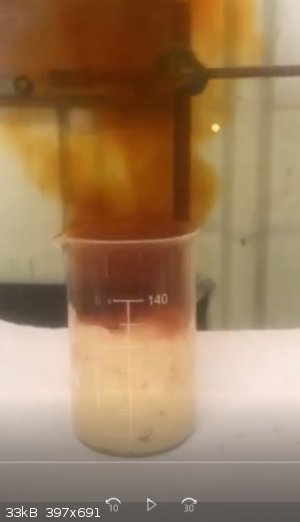 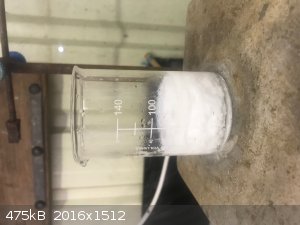 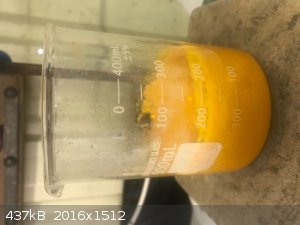 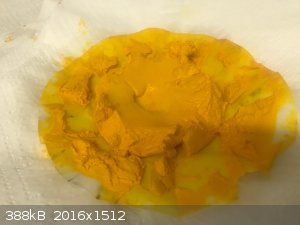 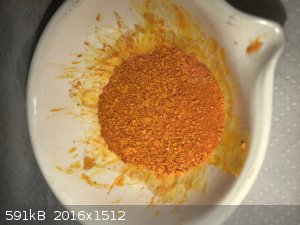 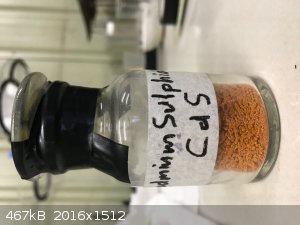
|
|
|